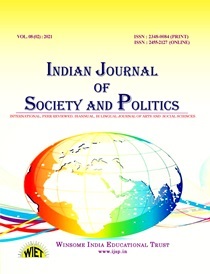Book Review : COVID19 and World Order: The Future of Conflict , Competition and Cooperation
Nithya N R
Affiliations:
-
Assistant Professor, Department of Political Science,University of KeralaThiruanantpuram, Kerala, INDIA
The COVID-19 pandemic has emerged as a transformative force, challenging the existing world order on multiple fronts. The unprecedented global health crisis has not only exposed vulnerabilities in public health systems but has also triggered profound shifts in geopolitics, economics, and societal structures. At the local, national, and international levels, the COVID-19 pandemic is altering how people live and political leaders make decisions. In the post-Covid world, a new global order is arising. Covid-19 has expedited the shift towards a more dispersed global order, where the principles guiding the future structure of the international system remain uncertain. The most obvious short-term result is escalating tensions between the US and China. It is become harder for a single nation to exert its will in the current geopolitical climate, as different poles engage in both competition and cooperation. The book Covid-19 and World Order: The Future of Conflict, Competition, and Cooperation (First Edition) by Hal Brands & Francis J. Gavin is an authentic contribution in comprehensively presenting the impact of the COVID-19 pandemic on our lives, and offer insights and ideas for the future. The dominant theme of the book is about how to shape international relations in a post-COVID world. Similar book entitled The world before and after Covid-19 by Gian Luca Gardini and Erlangen (2020) provides an overview on the impact of Covid-9 upon international relations and provides number of national and regional case studies.
The edited book composed of twenty three chapters excluding introduction. This book is divided in to seven parts; Applied History and Future Scenarios; Global Public Health and Mitigation Strategies; Transnational Issues; Technology, Climate, and Food; Future of the Global Economy; World Politics and Governance; Grand Strategy and American Statecraft; Sino-American Rivalry. It attempted to evaluate the current state of world order, analyze the effects of the COVID crisis, and offer insights and ideas for the future. It addressed the issues ranging from global public health and climate change to international institutions and great-power rivalry. The book is an attempt at answering the pertinent questions: how Covid 9 will impact all our lives going forward? How to shape international relations in a post-COVID 19 world?. how to rebuild world order after COVID ? How should we identify and understand these challenges to world order, and what principles and policies should form our efforts moving forward?
Applied History and current scenario involves using insights from the past to gain a deeper understanding of current challenges and opportunities, as well as to anticipate possible future scenarios. Part I of this book entitled Applied History and Future Scenarios comprises three chapters. Jeremy A. Greene and Dora Vargha’s chapter titled Ends of Epidemics address the most fundamental questions that we confront today ie, when will the biological phenomenon of this epidemic resolve?, (p.42), When will we move from a “world of COVID” to a “world after COVID”?, The answer they propose is that we are not likely to see any single instant that marks the end of the pandemic (p. 54). They also stress the role of WHO in responsible for the global governance of health. Margaret MacMillan’s essay on The World after Covid A Perspective from History raises the concern on why we are so frequently shocked by disasters that might have been predicted?, why some leaders and societies manage better than others?, The author demonstrates that we can better understand the pandemic by revisiting the trajectory of major upheavals in the past (p.64). The authors concludes by saying that, success in coping the pandemic depends on existing institutions, which include effective governing bodies and civil services, well-resourced education and research, and strong industrial and economic organizations (p.72). Future Scenarios “We are all failed states, now” by Philip Bobbitt considers why many faddish predictions about the post-covid world may be wrong and offers his own future scenario that of a deepening crisis of constitutional arrangements in major nation-states as a way of pushing us to prepare for an uncertain future (p.811). He criticized the post II W W international institutions that they are not capable of managing with the covid-19 pandemic (p.82). He considers situation construction as a vital tool for policy makers (p.93).
Addressing global public health challenges requires a comprehensive and collaborative approach, involving governments, non-governmental organizations, healthcare professionals, researchers, and communities working together to implement effective mitigation strategies. Part II of the book denominated Global Public Health and Mitigation Strategies has three chapters and Postulates the concern that there is no guarantee, after all, that the end of COVID will bring a relief from destructive worldwide disease. Tom Inglesby’s chapter Make Pandemics Lose Their Power illustrates a detailed account for making pandemics lose their power, and reminds us that the dichotomy between unilateral and multilateral responses is a false notion (p. 99). He further elaborated that the risks of future epidemics and biological threats are going to continue to grow (p. 102). He Conclude by suggesting that International organizations, especially WHO, as well as the private sector will need to be key partners in that global effort to contain epidemic (p.111). Lainie Rutkow’s thesis entitled Origins of the Covid-19 Pandemic and the Path Forward: A Global Public Health Policy Perspective highlights that decision makers must not, in the aftermath of the crisis, lose the sense of necessity that the pandemic creates. He raises two questions: How should we understand the origins and consequences of the COVID-19 crisis?, What should be our vision to craft a better world order for the future? (p.119). The author examines that the Covid-19 pandemic has caused a continued impact that touches on all aspects of society, leaving no one indifferent to the disaster’s consequences (p.135). To overcome today’s geopolitical and ideological factions, Lainie suggests for a new collaboration, coalitions, and networks will be needed (p.138). The book Uncharted Territory: Emerging World Order Post COVID-19 by Aarshi Tirkey (2021) critically analyse key factors that will shape the world’s journey to a post-COVID-19 era. Jeffrey P. Kahn, Anna C. Mastroianni, and Sridhar Venkatapuram’s in their chapter on Bioethics in a Post-COVID World: Time for Future-Facing Global Health Ethics demonstrate that catastrophe reveals the limits of bioethics as a field and underscores the need for a more holistic conception of what makes a global health system morally just (p.144). They argues that Bioethics needs to do better on a global health ethics that recognizes and takes account of the realities highlighted by the pandemic: focusing on health, not just health care; health equity, not just allocation of scarce resources; and social justice, not just distributive justice (p.155). Another book denominated Public Health and Economic Resiliency in the Post-COVID-19 Era, by Kholoud Kahime, Mustapha Zahir & others (2020), present some epidemiological studies of COVID-19, identify some Socio-economic human vulnerability related to the pandemic, and vulnerability factors of businesses and economic sectors.
Technology, Climate, and Food encompasses various aspects that play crucial roles in ensuring food security and sustainability. Part III of the book denominated Transnational Issues: Technology, Climate, and Food has three chapters. Chapter on Global Climate and Energy Policy after the COVID-19 Pandemic The Tug-of-War between Markets and Politics by Johannes Urpelainen, contends that the crisis, by temporarily suppressing global emissions, has created an opportunity to invest heavily in green technologies and perhaps head off the worst impacts of climate change. The author concludes by arguing that it could be destructive, with governments opting for nationalism and isolation. It could be constructive, as governments recognize the impossibility of progress without a much higher level of international cooperation. (p. 178). Jessica Fanzo’s chapter designated No Food Security, No World Order reminds us that Covid will dramatically deteriorated food insecurity around the world, a development likely to heighten political instability, geo-political conflict, and other forms of strife. She alerts us that “Without food security,” “there is no world order.” (p.192). The chapter concludes by suggesting that there must be greater partnership between institutions of governance, civil society, the multilateral system, and the private actors to reshape a post-crisis narrative about how the global food architecture and governments can better work together to improve access for all to safe, nutritious foods (p. 197). Christine Fox and Thayer Scott’s essay named Flat No Longer Technology in the Post-COVID World observes that Covid has aggregated the technological rivalry between the United States and China. The authors concludes by saying that When the world looks back on this pandemic, China’s strategic, opportunistic response may emerge as the turning point for the new world order (p.218). Similar book titled Political Communication and COVID-19 Governance and Rhetoric in Times of Crisis by Darren Lilleker, Ioana A. Coman, Miloš Gregor, Edoardo Novelli (2021), illustrates a global analysis of the responses and compares and analyses the most prominent political communicative responses to the outbreak and global spread of the COVID-19 strain of corona virus.
Predicting the future of the global economy involves recognizing the interconnected nature of various factors and the need for adaptive and resilient economic systems. Part IV of the book entitled The Future of the Global Economy has two chapters. Chapter on Models for a Post - Covid US Foreign Economic Policy by Benn Steil observes that the Covid pandemic is barely the origin of escalation economic conflict between the United States and China; it has evidently worsened that issue (p. 238). John Lipsky’s work on Prospects for the United States’ Post-Covid19 Policies Strengthening the G20 Leaders Process covers areas on world politics and governance, role of G20 questions the future of the G20 in a post-Covid-19 global economic governance. The author summed up by suggesting that failures of governance at the domestic level were accompanied by failures of governance at the global level (p.247). Global Economy and World Order in the Post-COVID-19 Era Edited By Zhao Jianying (2023), highlights the globalization trend in the economy, the possibility of a worldwide recession, the COVID-19-affected industrial chain, the post-pandemic world order, global governance, and the interactions between and among the major international powers.
"Global Politics and Governance" refer to the complex interactions, institutions, and systems that shape the behavior of nations, international relations, and the management of global affairs. Part V of the book titled Global Politics and Governance has four chapters. Anne Applebaum’s chapter denominated When the World Stumbled COVID-19 and the Failure of the International System observes a variety of factors, the abdication of American leadership, the determined Chinese effort to capture international institutions, and the fact that bodies created in the 20th century may lack the speed and agility the current moment requires. She felt that world’s democracies also essential to contemplate more approximately about their partnership strategy for a future world order (p.275). Chapter on Public Governance and Global Politics after COVID-19 by Henry Farrell and Hahrie Han considers the drawback of the liberal institutional order. The authors observes that Many policy makers now fear that global openness is self-undermining rather than self-sustaining (p.282). They concludes by arguing that the frustrations of the covid-19 pandemic, and the government’s failure to deal with the crisis, may lead to a new wave of public unrest, which may then be channeled into existing frustrations and will surely spill over into global politics (p.298). Janice Gross Stein’s Take It Off-Site World Order and International Institutions after COVID-19, emphasizes that the world is becoming more contested and competitive after COVID and that consensus-based institutions are not likely to perform well in such a world. If international governance is to work, it will have to go “off-site,” into informal networks and pluri-lateral coalitions working outside of existing bodies. James B. Steinberg’s chapter named A “Good Enough” World Order A Gardener’s Manual illustrates that the best way of salvaging some order from potential chaos is by rebuilding a system that emphasizes arrangements for addressing shared challenges, sets rules and norms for emerging technologies, engages public and civil society, and safely manages a competitive US-China relationship (p.327). James argued for a novel world order including the role of civil society engagement in developing norms and standards governing new and emerging technologies, particularly where scientific and technical expertise is critical to effective action (p.335). Ahmet Gökbel, Erman Ak?ll? and Burak Güne?’s book People, Power, and Politics in the Post-Pandemic World Order (2023) argues that a number of areas, including globalization, diplomacy, climate change, migration management, and regional politics, were significantly impacted by the COVID-19 epidemic.
Part VI of the book entitled Grand Strategy and American Statecraft has four chapters. Hal Brands, Peter Feaver, and William Inboden’s chapter titled Maybe It Won’t Be So Bad A Modestly Optimistic Take on COVID and World Order describes that the pandemic need not make the world far more menacing for the United States (p.357). It also highlights positive and negative dimensions of the rollback of globalization, adverse shifts in the balance of power, collapse of the liberal order, the decline of democracy and the ascent of illiberalism and populism (p.360). Hyun-hoon Lee and Donghyun Park’s book Post-covid Asia: Deglobalization, Fourth Industrial Revolution, And Sustainable Development (2021), also offers insights that would help governments, companies and people in Asia to ride the next wave of globalization to power their prosperity. Thomas Wright’s thesis on COVID-19’s Impact on Great-Power Competition calls for the United States to resist the understandable urge to fundamentally reorient its grand strategy toward transnational issues. He argues the better option would be a “free world” strategy focused on improving the resilience and solidarity of the world’s democracies against great-power revisionism and resurgent authoritarianism (p.379). Building a More Globalized Order by Kori Schake offers a moderately optimistic view, arguing that the pandemic could ultimately result in a renaissance of American global engagement, the strengthening of the domestic foundations of US power, and stronger efforts by free societies to deal with China’s rise. Kathleen H. Hicks Could the Pandemic Reshape World Order, American Security, and National Defense? Considers the crisis as an opportunity to revisit core elements of American grand strategy and improve the mix of tools the United States uses to protect and pursue its interests in the world (p.407). The United States and China matter tremendously to the emerging order, but states are glimpsing a true world of anarchy facilitated by these two powers, and they are looking beyond their own borders for ways to manage it (p.416). The book on Post Corona: From Crisis to Opportunity, by Scott Galloway (2020), also outlines the contours of the crisis and the opportunities that lie ahead such as businesses, industries, higher education, deeper trends in government and society, widening gap etc.
Part VII of the work denominated Sino-American Rivalry has four chapters. Elizabeth Economy’s chapter entitled The United States, China, and the Great Values Game offers a harsh assessment of the challenge that XiJinping’s China poses to the current global order. The author felt that the institutions, norms, and values of the existing world order are not acceptable to meet the range of needs and demands of the world’s peoples; some need to be bolstered, while others need to be reformed (p.424). Chapter on The US-China Relationship after Corona virus Clues from History by Graham Allison, raises three questions on world order and disorder: What lasting impact will corona virus have on relations between the United States and China? Could a rivalry partnership in a world safe for peaceful competition between diverse political systems serve as the starting point for a new strategic concept for managing the dangerous dynamic between China and the United States today? (p.460). As a conclusion Graham expressed the hope that political leaders learn from history to navigate a complicated, difficult, challenging rivalry one in which the United States and China have both competing interests and shared interests they have to manage in order to survive (p.448). Eric Schmidt’s chapter named Building a New Technological Relationship and Rivalry US-China Relations in the Aftermath of Covid challenges that technology has become the central alliance of great power rivalry and outlines an agenda meant to allow the United States to win this new “great game” without forgoing all the advantages of interchange and interdependence. The author also felt that today, the Chinese are competing to become the world’s leading innovators. The United States is not playing to win. That must change. Our way to technology leadership is a dual path: better protect our innovations and out-innovate our competitors (p.476). Chapter on From COVID War to Cold War The New Three-Body Problem by Niall Ferguson stating that a new cold war is very much under way. Ferguson warns that many of America’s allies are contemplating nonalignment in the present rivalry (p.480). He quoted the statement of Henry Kissinger, the pandemic “will forever alter the world order … the world will never be the same after the corona virus.” His answer is that COVID-19 has reminded many countries of the benefits of self reliance (p.483). I have lot of reservations with author’s assertion in this chapter. The contributors completely neglected the emergence of other emerging powers including India in the post covid world order. India Wakes: Post Corona virus New World Order by Bart S. Fisher (2020), presents the possible danger of the United States and China becoming adversaries in a new Cold War and advocates a balanced role by India to avoid such a catastrophe. Book titled Public Administration in the Time of COVID-19 by Scott E. Robinson, & Wesley Wehde (2020) illuminate public organization’s responses to COVID-19. Furthermore, it opines that response to COVID-19 will require networked responses from public organizations as well. US-China Strategic Competition in the Context of the Global COVID-19 Pandemic by Shelley Rigger & Jamie Rose Montagne (2023) explicates the strategic relations of China and USA, the balance of arrangement and rivalry shifted toward opposition after the Financial Crisis, the tension and concerns in the post COVID-19 international relations.
This book provides immense knowledge to the readers to understand the present state of affairs and the issues ranging from global public health and climate change to international institutions and great-power rivalry. The present book will be of great interest to scholars, policy makers and researchers of all disciplines. A significant critical examination on the book is that it ignored the contribution and prospects of emerging nations in the present world order. Reading through this book, I find that the contributors has ignored some relevant areas and issues with regard to the future of liberal democracy, role of Private sectors, Civil society groups and LSGs in the present state of affairs, the implications of covid 19 on society and polity in other democracies including India, covid 19 and the problems of marginalised sections, refugees and immigrants, changing nature of policy perceptions and the social Media, impact on livelihood, issues with regard to covid 19 vaccination. Despite all these criticisms, I strongly believe that the book will also be of great interest to health care professionals, researchers, bureaucrats, NGOs and government officials.
Keywords:
Book Review, World Order, COVID-19






